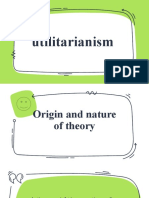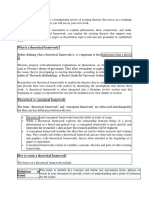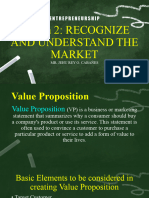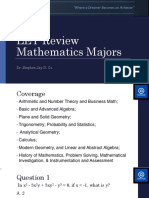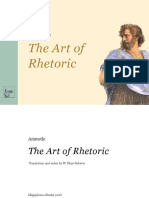Theoretical Framework
Uploaded by
Jehu Rey Obrero CabañesTheoretical Framework
Uploaded by
Jehu Rey Obrero CabañesDeveloping your theoretical framework
Published on October 14, 2015 by Sarah Vinz. Revised on October 22, 2020.
Theories are developed by researchers to explain phenomena, draw connections, and make
predictions. In the theoretical framework, you explain the theories that support your research,
showing that your work is grounded in established ideas.
Table of contents
1. The goal of a theoretical framework
2. How to create a theoretical framework
3. The structure of the theoretical framework
4. Example of a theoretical framework
The goal of a theoretical framework
Before you start your research, you have to explore what theories and models other researchers
have already developed. The goal of a theoretical framework is to present and explain this
information.
There may be many different theories about your topic, so the theoretical framework also
involves evaluating, comparing, and selecting the most relevant ones.
By “framing” your research within a clearly defined field, you make the reader aware of the
assumptions that inform your approach, showing the rationale behind your choices.
This part of your dissertation lays the foundations that will support your analysis, helping you
interpret your results and make broader generalizations.
Examples of theoretical frameworks in researchThe same research topic can be approached very
differently within different theoretical frameworks:
In literature, a scholar using postmodernist literary theory would analyze The Great
Gatsby differently than a scholar using Marxist literary theory.
In psychology, a behaviorist approach to depression would involve different methods and
assumptions than a psychoanalytical approach.
In economics, wealth inequality would be explained and interpreted differently within
classical economics and Keynesian economics frameworks.
In each of these cases, you would explain the theory you’re using in order to support your
interpretations and explanations of the data.
How to create a theoretical framework
To build your theoretical framework, follow these three steps.
1. Identify your key concepts
The first step is to pick out the key terms from your problem statement and research questions.
Concepts often have multiple definitions, so the theoretical framework involves clearly defining
what you mean by each term.
Example: Problem statement and research questionsCompany X is struggling with the problem
that many online customers do not return to make subsequent purchases. Management wants to
increase customer loyalty and believes that improved customer satisfaction will play a major role
in achieving this goal. To investigate this problem, you have identified and plan to focus on the
following problem statement, objective, and research questions:
Problem: Many online customers do not return to make subsequent purchases.
Objective: To increase customer loyalty.
Research question: How can the satisfaction of company X’s online customers be improved in
order to increase customer loyalty?
The concepts of “customer loyalty” and “customer satisfaction” are clearly central to this study.
The theoretical framework will define these concepts and discuss theories about the relationship
between them.
2. Evaluate and explain relevant theories
By conducting a thorough literature review, you can determine how other researchers have
defined and drawn connections between these key concepts. As you write the theoretical
framework, aim to compare and critically evaluate the approaches that different authors have
proposed.
After discussing different models and theories, you establish the definitions that best fit your
research and justify why this is the case. In more complex research projects, you might combine
theories from different fields to build your own unique framework.
Make sure to mention the most important theories related to your key concepts. If there is a well-
established theory or model that you don’t want to apply to your own research, explain why it
isn’t suitable for your purposes.
3. Show how your research fits in
Apart from discussing other people’s theories, the theoretical framework should show how your
own project will make use of these ideas.
You might aim to do one or more of the following:
Test whether a theory holds in a specific context
Use theory as a basis for interpreting your results
Critique or challenge a theory
Combine different theories in a new or unique way
If relevant, you can also use the theoretical framework to develop hypotheses for your research.
The structure of the theoretical framework
In a thesis or dissertation, the theoretical framework is sometimes integrated into a literature
review chapter, but it can also be included as its own chapter or section. If your research involves
dealing with a lot of complex theories, it’s a good idea to include a separate theoretical
framework chapter.
There are no fixed rules for structuring a theoretical framework. The important thing is to create
a clear, logical structure. One option is to draw on your research questions, structuring each
section around a question or key concept.
As in all other parts of your thesis, make sure to properly cite your sources to avoid plagiarism.
Sample theoretical framework of a
dissertation
Published on October 14, 2015 by Sarah Vinz. Revised on August 14, 2020.
The theoretical framework defines the key concepts in your research, proposes relations between
them, and discusses relevant theories based on a literature review.
A strong theoretical framework gives your research direction, allowing you to convincingly
interpret, explain and generalize from your findings.
Table of contents
1.
2.
Sample problem statement and research questions
Your problem statement, research questions and literature review will serve as the basis for
preparing your theoretical framework.
Company X is struggling with the problem that many online customers do not return to make
subsequent purchases. Management wants to increase customer loyalty and believes that
improved customer satisfaction will play a major role in achieving this goal.
To investigate this problem, you have identified the following problem statement, objective, and
research questions:
Problem: Many online customers do not return to make subsequent purchases.
Objective: To increase customer loyalty and thereby generate more revenue.
Research question: ‘How can the satisfaction of company X’s online customers be improved in
order to increase customer loyalty?’
Sub-Questions:
1. ‘What is the relationship between customer loyalty and customer satisfaction?’
2. ‘How satisfied and loyal are company X’s online customers currently?’
3. ‘What factors affect the satisfaction and loyalty of company X’s online customers?’
As the concepts of “loyalty” and “customer satisfaction” play a major role in the investigation
and will later be measured, they are essential concepts to define within the theoretical
framework.
Sample theoretical framework
Below is a (simplified) example of how you can describe and compare definitions and theories.
In this example, we focus on the concept of ‘customer satisfaction.’
2.1 Customer satisfaction
Thomassen (2003, p. 69) defines customer satisfaction as “the perception of the customer as a
result of consciously or unconsciously comparing their experiences with their expectations.”
Kotler & Keller (2008, p. 80) build on this definition, stating that customer satisfaction is
determined by “the degree to which someone is happy or disappointed with the observed
performance of a product in relation to his or her expectations.” Performance that is below
expectations leads to a dissatisfied customer, while performance that satisfies expectations
produces satisfied customers. Expectations being exceeded leads to a “very satisfied or even
pleasantly surprised customer” (Kotler & Keller, 2003, p. 80).
The definition of Zeithaml and Bitner (2003, p. 86) is slightly different from that of Thomassen:
“Satisfaction is the consumer fulfillment response. It is a judgement that a product or service
feature, or the product of service itself, provides a pleasurable level of consumption-related
fulfillment.” Zeithaml and Bitner’s emphasis is thus on obtaining a certain satisfaction in relation
to purchasing.
Thomassen’s definition is the most relevant to the aims of this study, given the emphasis it
places on unconscious perception. Although Zeithaml and Bitner, like Thomassen, say that
customer satisfaction is a reaction to the experience gained, there is no distinction between
conscious and unconscious comparisons in their definition. Company X claims in its mission
statement that it wants to sell not only a product, but also a feeling; as a result, unconscious
comparison will play an important role in the satisfaction of its customers. Thomassen’s
definition is therefore more relevant to the current study.
Thomassen’s Customer Satisfaction Model
According to Thomassen, both the so-called value proposition and other influences have an
impact on final customer satisfaction. In his satisfaction model (Fig. 1), Thomassen shows that
word-of-mouth, personal needs, past experiences, and marketing and public relations determine
customers’ needs and expectations. These factors are compared to their experiences, and this
comparison between expectations and experiences determines a customer’s satisfaction level.
Thomassen’s model is important for this study: it allows us to determine both the extent to which
company X’s customers are satisfied and where improvements can be made.
Fig. 1: Customer satisfaction creation (Thomassen, 2007, p.30).
Of course, you could analyze the concepts more thoroughly and compare additional definitions
to each other. You could also discuss the theories and ideas of key authors in greater detail and
provide several models to illustrate different concepts.
You might also like
- Taf - The Framework For Theory Into PracticeNo ratings yetTaf - The Framework For Theory Into Practice11 pages
- Effects of Presession Pairing On Preference For Therapeutic ConditionsNo ratings yetEffects of Presession Pairing On Preference For Therapeutic Conditions6 pages
- Estimating Repetitions in Reserve For Resistance Exercise An Analysis of Factors Which Impact On Prediction Accuracy PDFNo ratings yetEstimating Repetitions in Reserve For Resistance Exercise An Analysis of Factors Which Impact On Prediction Accuracy PDF7 pages
- The Macro-Micro Problem and The Problem of Structure and AgencyNo ratings yetThe Macro-Micro Problem and The Problem of Structure and Agency15 pages
- The Little Book of Stoicism - 55 Practices - Checklist100% (3)The Little Book of Stoicism - 55 Practices - Checklist11 pages
- Dube Teaching Discrimination Skills To Persons With Mental RetardationNo ratings yetDube Teaching Discrimination Skills To Persons With Mental Retardation23 pages
- Teaching Practitioners To Conduct Behavioral Skills Training: A Pyramidal Approach For Training Multiple Human Service StaffNo ratings yetTeaching Practitioners To Conduct Behavioral Skills Training: A Pyramidal Approach For Training Multiple Human Service Staff13 pages
- Systematic Review Emotion Dysregulation and ChalleNo ratings yetSystematic Review Emotion Dysregulation and Challe24 pages
- VB-MAPP Task Analysis Rafael Adonis - Escola100% (1)VB-MAPP Task Analysis Rafael Adonis - Escola9 pages
- IISCA, Uma Proposta de Análise Funcional: Felipe Magalhães Lemos Joshua JesselNo ratings yetIISCA, Uma Proposta de Análise Funcional: Felipe Magalhães Lemos Joshua Jessel14 pages
- (Autism and Child Psychopathology Series) Michael Siller, Lindee Morgan - Handbook of Parent-Implemented Interventions for Very Young Children With Autism-Springer International Publishing (2018)No ratings yet(Autism and Child Psychopathology Series) Michael Siller, Lindee Morgan - Handbook of Parent-Implemented Interventions for Very Young Children With Autism-Springer International Publishing (2018)497 pages
- Apostila - Alunos - de - Inclusao InglêsNo ratings yetApostila - Alunos - de - Inclusao Inglês23 pages
- Download Full Nonlinear Contingency Analysis Going Beyond Cognition and Behavior in Clinical Practice 1st Edition T. V. Joe Layng PDF All Chapters100% (3)Download Full Nonlinear Contingency Analysis Going Beyond Cognition and Behavior in Clinical Practice 1st Edition T. V. Joe Layng PDF All Chapters40 pages
- Moore (2001) On Distinguishing Methodological Form Radical BehaviorismNo ratings yetMoore (2001) On Distinguishing Methodological Form Radical Behaviorism24 pages
- Materiais Detalhamento VB-MAPP COMPLETONo ratings yetMateriais Detalhamento VB-MAPP COMPLETO47 pages
- EFL FEAT NT FEB 2019 - Vincent Carbone 1No ratings yetEFL FEAT NT FEB 2019 - Vincent Carbone 1143 pages
- Publish To The World: Presentations, Research Papers, Legal Documents, and More0% (2)Publish To The World: Presentations, Research Papers, Legal Documents, and More7 pages
- IISCA, Uma Proposta de Análise Funcional: Felipe Magalhães Lemos Joshua JesselNo ratings yetIISCA, Uma Proposta de Análise Funcional: Felipe Magalhães Lemos Joshua Jessel14 pages
- DNAv CARDS Hayes & Ciarrochi (2021) WWW - Dnav.international100% (1)DNAv CARDS Hayes & Ciarrochi (2021) WWW - Dnav.international91 pages
- Hales, G., Mclarney, C. (2017) - Uber's Competitive Advantage Vis-A-Vis Porte R's Generic StrategiesNo ratings yetHales, G., Mclarney, C. (2017) - Uber's Competitive Advantage Vis-A-Vis Porte R's Generic Strategies17 pages
- Analysis of The Pragmatic Abilities Profile in NorNo ratings yetAnalysis of The Pragmatic Abilities Profile in Nor11 pages
- Fillable - Getting Ready For Distance CoachingNo ratings yetFillable - Getting Ready For Distance Coaching1 page
- Parent-Child Interactions - A Home Visitors Guide Rev Appendices 1 2No ratings yetParent-Child Interactions - A Home Visitors Guide Rev Appendices 1 28 pages
- Instructional Control Developing A RelationalNo ratings yetInstructional Control Developing A Relational22 pages
- 14-Components-of-the-Research-Process-Theoretical-FrameworkNo ratings yet14-Components-of-the-Research-Process-Theoretical-Framework30 pages
- Theoretical Framework Example For A Thesis or DissertationNo ratings yetTheoretical Framework Example For A Thesis or Dissertation5 pages
- What Is A Theoretical Framework - Guide To OrganizingNo ratings yetWhat Is A Theoretical Framework - Guide To Organizing10 pages
- Sample Thesis Theoretical Conceptual Framework100% (3)Sample Thesis Theoretical Conceptual Framework6 pages
- Lesson 2 RECOGNIZE AND UNDERSTAND THE MARKETNo ratings yetLesson 2 RECOGNIZE AND UNDERSTAND THE MARKET25 pages
- LP in Research Project Data Presentation and AnalysisNo ratings yetLP in Research Project Data Presentation and Analysis2 pages
- LP in Research Project Guidelines in Writing Summary of Findings Conclusions and RecommendationsNo ratings yetLP in Research Project Guidelines in Writing Summary of Findings Conclusions and Recommendations3 pages
- LP in Research Project Guidelines in Making Conclusions and RecommendationsNo ratings yetLP in Research Project Guidelines in Making Conclusions and Recommendations3 pages
- Mathematics Major Final Coaching Review 2No ratings yetMathematics Major Final Coaching Review 2106 pages
- Practical Research 2: Arellano UniversityNo ratings yetPractical Research 2: Arellano University1 page
- Importance of Quantitative Research and Kinds of VariablesNo ratings yetImportance of Quantitative Research and Kinds of Variables42 pages
- Significance and Beneficiaries of StudyNo ratings yetSignificance and Beneficiaries of Study22 pages
- VO: Ladies and Gentlemen, Please All Stand For The Invocation To Be FollowedNo ratings yetVO: Ladies and Gentlemen, Please All Stand For The Invocation To Be Followed4 pages
- Black Maoism But Make It Fashion - How The Black Panther Party UtNo ratings yetBlack Maoism But Make It Fashion - How The Black Panther Party Ut49 pages
- Revisiting Feminist Approaches To Art Therapy Edited by Susan Hogan (2012) - BreghahnNo ratings yetRevisiting Feminist Approaches To Art Therapy Edited by Susan Hogan (2012) - Breghahn4 pages
- Cream Modern Simple & Lined Thesis Defense PresentationNo ratings yetCream Modern Simple & Lined Thesis Defense Presentation5 pages
- Defination and Scop of Social Psychology PDF100% (1)Defination and Scop of Social Psychology PDF75 pages
- CCNY Pathways Common Core Courses Fall 2023No ratings yetCCNY Pathways Common Core Courses Fall 20232 pages
- The Healing Temples of Venus by Sapphire of Venus Natalie GlassonNo ratings yetThe Healing Temples of Venus by Sapphire of Venus Natalie Glasson4 pages
- Ray Brassier Jameson On Making History Appear 2No ratings yetRay Brassier Jameson On Making History Appear 28 pages
- (1) The Creator خالق کائنات کون؟ - Salaam One سلامNo ratings yet(1) The Creator خالق کائنات کون؟ - Salaam One سلام17 pages
- Brian Black, The Character of The Self in Ancient IndiaNo ratings yetBrian Black, The Character of The Self in Ancient India27 pages
- The Relationship Between International LawNo ratings yetThe Relationship Between International Law11 pages
- Effects of Presession Pairing On Preference For Therapeutic ConditionsEffects of Presession Pairing On Preference For Therapeutic Conditions
- Estimating Repetitions in Reserve For Resistance Exercise An Analysis of Factors Which Impact On Prediction Accuracy PDFEstimating Repetitions in Reserve For Resistance Exercise An Analysis of Factors Which Impact On Prediction Accuracy PDF
- The Macro-Micro Problem and The Problem of Structure and AgencyThe Macro-Micro Problem and The Problem of Structure and Agency
- The Little Book of Stoicism - 55 Practices - ChecklistThe Little Book of Stoicism - 55 Practices - Checklist
- Dube Teaching Discrimination Skills To Persons With Mental RetardationDube Teaching Discrimination Skills To Persons With Mental Retardation
- Teaching Practitioners To Conduct Behavioral Skills Training: A Pyramidal Approach For Training Multiple Human Service StaffTeaching Practitioners To Conduct Behavioral Skills Training: A Pyramidal Approach For Training Multiple Human Service Staff
- Systematic Review Emotion Dysregulation and ChalleSystematic Review Emotion Dysregulation and Challe
- IISCA, Uma Proposta de Análise Funcional: Felipe Magalhães Lemos Joshua JesselIISCA, Uma Proposta de Análise Funcional: Felipe Magalhães Lemos Joshua Jessel
- (Autism and Child Psychopathology Series) Michael Siller, Lindee Morgan - Handbook of Parent-Implemented Interventions for Very Young Children With Autism-Springer International Publishing (2018)(Autism and Child Psychopathology Series) Michael Siller, Lindee Morgan - Handbook of Parent-Implemented Interventions for Very Young Children With Autism-Springer International Publishing (2018)
- Download Full Nonlinear Contingency Analysis Going Beyond Cognition and Behavior in Clinical Practice 1st Edition T. V. Joe Layng PDF All ChaptersDownload Full Nonlinear Contingency Analysis Going Beyond Cognition and Behavior in Clinical Practice 1st Edition T. V. Joe Layng PDF All Chapters
- Moore (2001) On Distinguishing Methodological Form Radical BehaviorismMoore (2001) On Distinguishing Methodological Form Radical Behaviorism
- Publish To The World: Presentations, Research Papers, Legal Documents, and MorePublish To The World: Presentations, Research Papers, Legal Documents, and More
- IISCA, Uma Proposta de Análise Funcional: Felipe Magalhães Lemos Joshua JesselIISCA, Uma Proposta de Análise Funcional: Felipe Magalhães Lemos Joshua Jessel
- DNAv CARDS Hayes & Ciarrochi (2021) WWW - Dnav.internationalDNAv CARDS Hayes & Ciarrochi (2021) WWW - Dnav.international
- Hales, G., Mclarney, C. (2017) - Uber's Competitive Advantage Vis-A-Vis Porte R's Generic StrategiesHales, G., Mclarney, C. (2017) - Uber's Competitive Advantage Vis-A-Vis Porte R's Generic Strategies
- Analysis of The Pragmatic Abilities Profile in NorAnalysis of The Pragmatic Abilities Profile in Nor
- Parent-Child Interactions - A Home Visitors Guide Rev Appendices 1 2Parent-Child Interactions - A Home Visitors Guide Rev Appendices 1 2
- 14-Components-of-the-Research-Process-Theoretical-Framework14-Components-of-the-Research-Process-Theoretical-Framework
- Theoretical Framework Example For A Thesis or DissertationTheoretical Framework Example For A Thesis or Dissertation
- What Is A Theoretical Framework - Guide To OrganizingWhat Is A Theoretical Framework - Guide To Organizing
- LP in Research Project Data Presentation and AnalysisLP in Research Project Data Presentation and Analysis
- LP in Research Project Guidelines in Writing Summary of Findings Conclusions and RecommendationsLP in Research Project Guidelines in Writing Summary of Findings Conclusions and Recommendations
- LP in Research Project Guidelines in Making Conclusions and RecommendationsLP in Research Project Guidelines in Making Conclusions and Recommendations
- Importance of Quantitative Research and Kinds of VariablesImportance of Quantitative Research and Kinds of Variables
- VO: Ladies and Gentlemen, Please All Stand For The Invocation To Be FollowedVO: Ladies and Gentlemen, Please All Stand For The Invocation To Be Followed
- Black Maoism But Make It Fashion - How The Black Panther Party UtBlack Maoism But Make It Fashion - How The Black Panther Party Ut
- Revisiting Feminist Approaches To Art Therapy Edited by Susan Hogan (2012) - BreghahnRevisiting Feminist Approaches To Art Therapy Edited by Susan Hogan (2012) - Breghahn
- Cream Modern Simple & Lined Thesis Defense PresentationCream Modern Simple & Lined Thesis Defense Presentation
- The Healing Temples of Venus by Sapphire of Venus Natalie GlassonThe Healing Temples of Venus by Sapphire of Venus Natalie Glasson
- (1) The Creator خالق کائنات کون؟ - Salaam One سلام(1) The Creator خالق کائنات کون؟ - Salaam One سلام
- Brian Black, The Character of The Self in Ancient IndiaBrian Black, The Character of The Self in Ancient India












